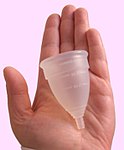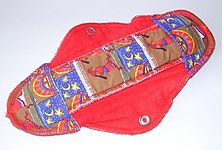Menstruation and sex
Sexual intercourse during menstruation does not cause damage in of itself, but the woman's body is more vulnerable during this time.Vaginal pH is higher and less acidic than normal, the cervix is lower in its position, the cervical opening is more dilated, and the uterine endometrial lining is absent, thus allowing organisms direct access to the blood stream through the numerous blood vessels that nourish the uterus.
All these conditions increase the chance of infection and STD transmission during menstruation.
Sexual intercourse may also shorten the menstrual period. Some sources say that achieving orgasm helps the uterus to contract and expel the lining.
However, it is more likely that because semen contains luteinizing hormone (LH) and follicle stimulating hormone (FSH), and the vagina easily absorbs these hormones, the woman's hormone balance is slightly offset and the follicular phase of the menstrual cycle begins earlier.
Similarly, levonorgestrel-releasing intrauterine devices and oral birth control pills alter the default hormone-release cycle, although by different mechanisms such as maintaining a high progestin level throughout a woman's cycle.
Menstruation and pregnancy
Menstruation is the most visible phase of the menstrual cycle, and corresponds closely with the hormonal cycle, and is therefore used as the limit between cycles; Menstrual cycles are counted from the first day of menstrual bleeding, a point in time commonly termed last menstrual period (LMP). The time from LMP until ovulation is, on average, 14.6 days, but with substantial variation both between people and between cycles in any single person, with an overall 95% prediction interval of 8.2 to 20.5 days.During pregnancy and for some time after childbirth, menstruation is normally suspended; this state is known as amenorrhoea, i.e. absence of the menstrual cycle. If menstruation has not resumed, fertility is low during lactation. The average length of postpartum amenorrhoea is longer when certain breastfeeding practices are followed; this may be done intentionally as birth control.
Use of synthetic hormones to control menstruation
Many women have chosen to control the frequency of menstruation with hormonal birth control which is often called 'the pill'. They are most often combined hormone pills containing estrogen and are taken in 28 day cycles, 21 hormonal pills with either a 7 day break from pills, or 7 placebo pills during which the person menstruates.Hormonal contraception acts by using low doses of hormones to prevent ovulation, and thus prevent conception in sexually active females. But by using placebo pills for a 7-day span during the month, a regular bleeding period is still experienced.
Injections such as depo-provera became available in the 1960s. Progestogen implants such as Norplant in the 1980s and extended cycle combined oral contraceptive pills in the early 2000s.
Using synthetic hormones, it is possible for a person to completely eliminate menstrual periods.
When using progestogen implants, menstruation may be reduced to 3 or 4 menstrual periods per year. By taking progestogen-only contraceptive pills (sometimes called the 'mini-pill') continuously without a 7-day span of using placebo pills, the menstrual period is eliminated entirely. Some people do this simply for convenience in the short-term, while others prefer to eliminate periods altogether when possible.
Menstrual Suppression
Some people use hormonal contraception in this way to eliminate their periods for months or years at a time, a practise called menstrual suppression. When the first birth control pill was being developed, the researchers were aware that they could use the contraceptive to space menstrual periods up to 90 days apart, but they settled on a 28-day cycle that would mimic a natural menstrual cycle and produce monthly periods.The intention behind this decision was the hope of the inventor, John Rock, to win approval for his invention from the Roman Catholic Church.
That attempt failed, but the 28-day cycle remained the standard when the pill became available to the public. There is debate among medical researchers about the potential long-term impacts of these practises upon female health.
Some researchers point to the fact that historically, females have had far fewer menstrual periods throughout their lifetimes, a result of shorter life expectancies, as well as a greater length of time spent pregnant or breast-feeding, which reduced the number of periods experienced by females.
These researchers believe that the higher number of menstrual periods experienced by females in modern societies may have a negative impact upon their health. On the other hand, some researchers believe there is a greater potential for negative impacts from exposing females perhaps unnecessarily to regular low doses of synthetic hormones over their reproductive years.
Menstrual products
Most people use something to absorb or catch their menses. There are a number of different methods available.Reusable items
- Reusable cloth pads — Pads that are made of cotton (often organic), terrycloth, or flannel, and may be handsewn (from material or reused old clothes and towels) or storebought.
- Menstrual cups — A firm, flexible bell-shaped device worn inside the vagina to catch menstrual flow. Reusable versions include rubber or silicone cups. Sterilised after each period.
- Sea sponges — Natural sponges, worn internally like a tampon to absorb menstrual flow.
- Padded panties — Reusable cloth (usually cotton) underwear with extra absorbent layers sewn in to absorb flow.
- Blanket, towel — (also known as a draw sheet) large reusable piece of cloth, most often used at night, placed between legs to absorb menstrual flow.
Disposable items
- Sanitary napkins (Sanitary towels) or pads — Somewhat rectangular pieces of material worn in the underwear to absorb menstrual flow, often with "wings," pieces that fold around the undergarment and/or an adhesive backing to hold the pad in place. Disposable pads may contain wood pulp or gel products, usually with a plastic lining and bleached. Some sanitary napkins, particularly older styles, are held in place by a belt-like apparatus, instead of adhesive or wings.
- Tampons — Disposable cylinders of treated rayon/cotton blends or all-cotton fleece, usually bleached, that are inserted into the vagina to absorb menstrual flow.
- Padettes — Disposable wads of treated rayon/cotton blend fleece that are placed within the inner labia to absorb menstrual flow.
- Disposable menstrual cups — A firm, flexible cup-shaped device worn inside the vagina to catch menstrual flow. Disposable cups are made of soft plastic.

















0 comments:
Post a Comment